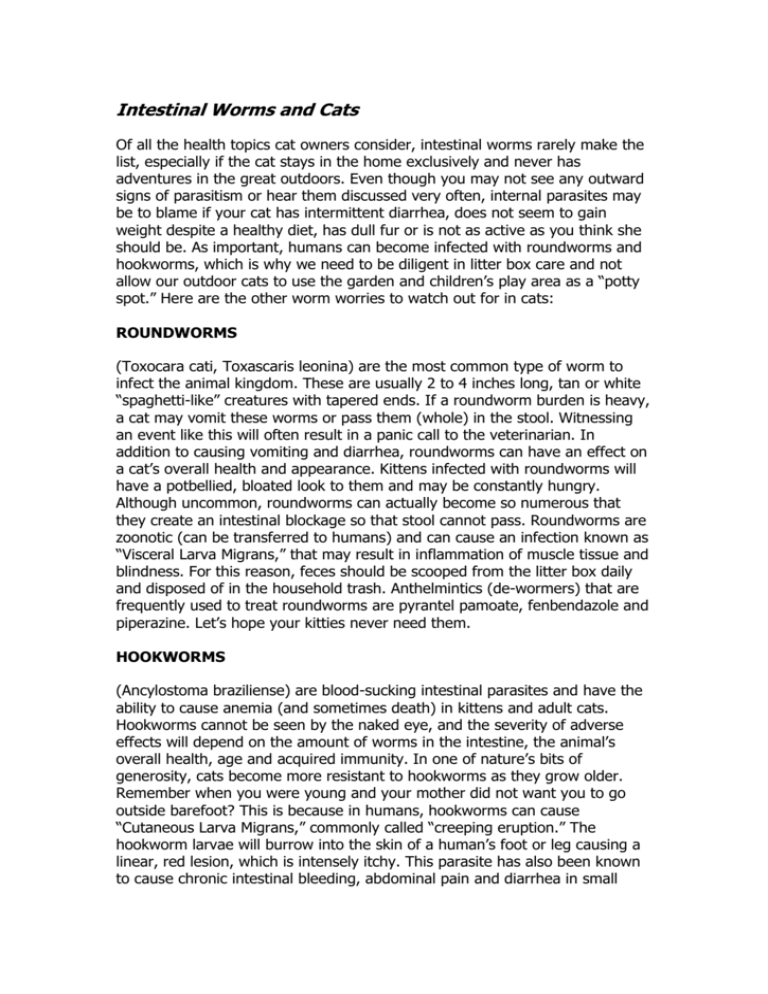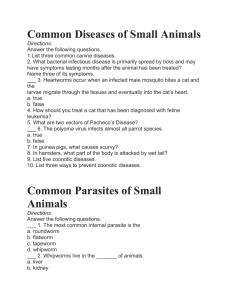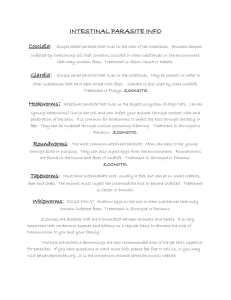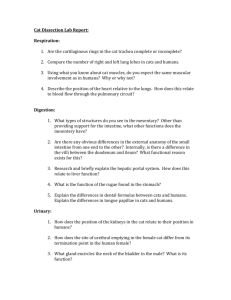Intestinal Worms and Cats - Feline 5 Star Accommodation
advertisement

Intestinal Worms and Cats Of all the health topics cat owners consider, intestinal worms rarely make the list, especially if the cat stays in the home exclusively and never has adventures in the great outdoors. Even though you may not see any outward signs of parasitism or hear them discussed very often, internal parasites may be to blame if your cat has intermittent diarrhea, does not seem to gain weight despite a healthy diet, has dull fur or is not as active as you think she should be. As important, humans can become infected with roundworms and hookworms, which is why we need to be diligent in litter box care and not allow our outdoor cats to use the garden and children’s play area as a “potty spot.” Here are the other worm worries to watch out for in cats: ROUNDWORMS (Toxocara cati, Toxascaris leonina) are the most common type of worm to infect the animal kingdom. These are usually 2 to 4 inches long, tan or white “spaghetti-like” creatures with tapered ends. If a roundworm burden is heavy, a cat may vomit these worms or pass them (whole) in the stool. Witnessing an event like this will often result in a panic call to the veterinarian. In addition to causing vomiting and diarrhea, roundworms can have an effect on a cat’s overall health and appearance. Kittens infected with roundworms will have a potbellied, bloated look to them and may be constantly hungry. Although uncommon, roundworms can actually become so numerous that they create an intestinal blockage so that stool cannot pass. Roundworms are zoonotic (can be transferred to humans) and can cause an infection known as “Visceral Larva Migrans,” that may result in inflammation of muscle tissue and blindness. For this reason, feces should be scooped from the litter box daily and disposed of in the household trash. Anthelmintics (de-wormers) that are frequently used to treat roundworms are pyrantel pamoate, fenbendazole and piperazine. Let’s hope your kitties never need them. HOOKWORMS (Ancylostoma braziliense) are blood-sucking intestinal parasites and have the ability to cause anemia (and sometimes death) in kittens and adult cats. Hookworms cannot be seen by the naked eye, and the severity of adverse effects will depend on the amount of worms in the intestine, the animal’s overall health, age and acquired immunity. In one of nature’s bits of generosity, cats become more resistant to hookworms as they grow older. Remember when you were young and your mother did not want you to go outside barefoot? This is because in humans, hookworms can cause “Cutaneous Larva Migrans,” commonly called “creeping eruption.” The hookworm larvae will burrow into the skin of a human’s foot or leg causing a linear, red lesion, which is intensely itchy. This parasite has also been known to cause chronic intestinal bleeding, abdominal pain and diarrhea in small children and the symptoms aren’t any nicer for cats. De-worming medications usually include pyrantel pamoate and fenbendazole. TAPEWORMS (Dipylidium caninum, T. taeniaeformis) are the other type of parasite that’s visible to the naked eye. Actually, what you will observe are tapeworm segments that have broken off from the adult parasite that is attached to the lining of the cat’s intestinal tract. These tapeworm pieces vary in length, are usually white and are frequently seen (while still alive) contracting and expanding around the cat’s rectum or on a dog’s stool immediately after elimination. Once the segments die, they will look like grains of uncooked wild rice or sesame seeds and are often found where the cat sleeps. If you think this is as gross as most people, you’ll want to protect your cat with effective flea prevention. That’s right: The most common route of infection occurs when the cat swallows a flea that is carrying the parasite’s eggs. The good news is that tapeworms cannot be directly transmitted from cats to dogs or humans; in both infections the flea needs to be involved in the lifecycle process. Deworming can be done by either oral medication or by injection and the most common antiparasitic agent used is praziquantel followed up by epsiprantel (Cestex). COCCIDA (Isopora felis) is not a worm, but a single-cell microscopic organism that will wreak havoc in a cat’s intestinal tract when present in great numbers. This protozoa will cause watery diarrhea in young and susceptible animals that have immature or compromised immune systems; in some cases, the diarrhea can be severe enough to be life-threatening. Eradication of this parasite is usually successful with a daily dose of a sulfonamide antimicrobial agent. It is important to know that most cats will not even show signs of intestinal parasitism at first; the initial step in parasite control is having a stool sample tested by your veterinarian. If the fecal exam is positive, the proper medication can be prescribed or recommended for purging that particular worm. If you are ever in doubt about the proper medication to use, be sure to consult your veterinary care professional before proceeding and never use a de-wormer on a cat that is otherwise sick, pregnant or debilitated. Worms are a health risk for sure, but properly treated can be cured effectively.






